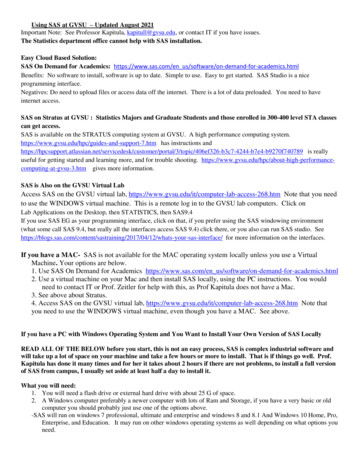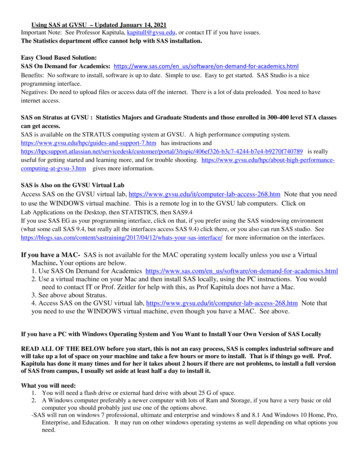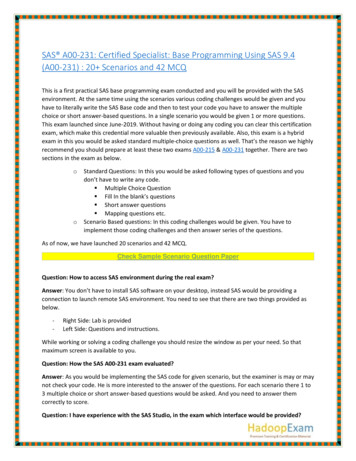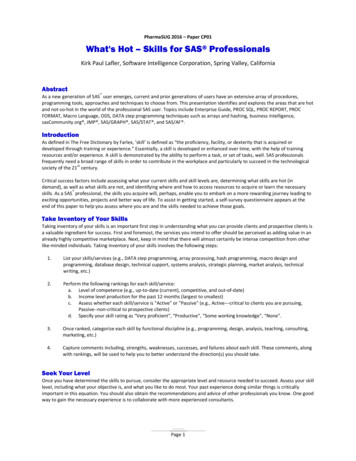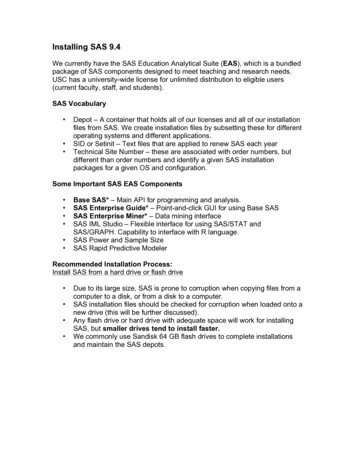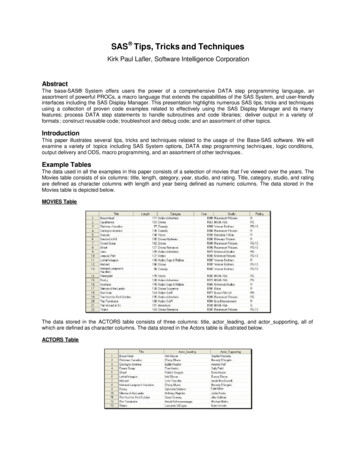
Transcription
SAS Tips, Tricks and TechniquesKirk Paul Lafler, Software Intelligence CorporationAbstractThe base-SAS System offers users the power of a comprehensive DATA step programming language, anassortment of powerful PROCs, a macro language that extends the capabilities of the SAS System, and user-friendlyinterfaces including the SAS Display Manager. This presentation highlights numerous SAS tips, tricks and techniquesusing a collection of proven code examples related to effectively using the SAS Display Manager and its manyfeatures; process DATA step statements to handle subroutines and code libraries; deliver output in a variety offormats ; construct reusable code; troubleshoot and debug code; and an assortment of other topics.IntroductionThis paper illustrates several tips, tricks and techniques related to the usage of the Base-SAS software. We willexamine a variety of topics including SAS System options, DATA step programming techniques , logic conditions,output delivery and ODS, macro programming, and an assortment of other techniques .Example TablesThe data used in all the examples in this paper consists of a selection of movies that I’ve viewed over the years. TheMovies table consists of six columns: title, length, category, year, studio, and rating. Title, category, studio, and ratingare defined as character columns with length and year being defined as numeric columns. The data stored in theMovies table is depicted below.MOVIES TableThe data stored in the ACTORS table consists of three columns: title, actor leading, and actor supporting, all ofwhich are defined as character columns. The data stored in the Actors table is illustrated below.ACTORS Table
Base-SAS Tips, Tricks and TechniquesThis section covers numerous base-SAS software tips , tricks and techniques . Whether you are a SAS expert who iscomfortable with the many features offered in the Base SAS product or someone just getting started, these tips willmake your programming experience a more rewarding one. By taking the time to learn the Base SAS fundamentals —including terminology, library structures, programming concepts, user interface, SAS Explorer, and numerous otheraspects —you will get better results using this powerful product. You will learn about useful features step-by-step tohelp you become a more knowledgeable SAS user.Tip #1 – Writing SAS source files included with a %INCLUDE statement to the SAS LogBy default, SAS source statements included with a %INCLUDE statement are NOT automatically written to the SASLog. To print secondary SAS source statements included with a %INCLUDE statements, users will need to specifythe SOURCE2 system option. The default setting is NOSOURCE2. Either option can be specified in an OPTIONSstatement, in the OPTIONS window, at SAS invocation, or in the configuration file.Tip #2 – Specifying the most recently created data set to use in a read operationBy default, the LAST system option is set to use the most recently created data set. This automatic feature iscommonly found in procedure code when the DATA option is omitted from a PROC. To override this built-in default,the LAST system option can be defined as any valid temporary or permanent SAS data set name (refer to dataset naming conventions). The LAST option can be specified in an OPTIONS statement, in the OPTIONS window,at SAS invocation, or in the configuration file.Tip #3 – Preventing SAS data sets from accidentally being replacedUsers can specify the NOREPLACE system option to prevent a permanent SAS data set from being accidentallyreplaced with another like-named data set. Conversely, by specifying the REPLACE system option like-named datasets can be overwritten. The REPLACE NOREPLACE option can be specified in an OPTIONS statement, in theOPTIONS window, at SAS invocation, or in the configuration file.Tip #4 – Executing Conditional Logic with IF-THEN / ELSEThe IF-THEN / ELSE construct enables a sequence of conditions to be constructed that when executed goes throughthe IF-THEN conditions until it finds one that satisfies the expression. The example shows a variable Movie Lengthbeing assigned a character value of “Short”, “Medium”, or “Long” based on the mutually exclusive conditions specifiedin the IF-THEN and ELSE conditions. Although not required, the ELSE condition is useful to prevent missing valuesfrom being assigned to Movie Length.Code:DATA ATTRIB EXAMPLE;ATTRIB Movie Length LENGTH 7 LABEL ’Movie Length’;SET MOVIES;IF LENGTH 120 THEN Movie Length ‘Short’;ELSE IF LENGTH 160 THEN Movie Length ‘Long’;ELSE Movie Length ‘Medium’;RUN;ResultsThe SAS SystemTitleBrave HeartCasablancaChristmas VacationComing to AmericaDraculaDressed to KillForrest GumpGhostLength17710397116130105142127Movie LengthLongShortShortShortMediumShortMediumMedium
JawsJurassic ParkLethal WeaponMichaelNational Lampoon's VacationPoltergeistRockyScarfaceSilence of the LambsStar WarsThe Hunt for Red OctoberThe TerminatorThe Wizard of iumMediumShortShortLongTip #5 – Executing Conditional Logic with a SELECT statementAs an alternative to a series of IF-THEN/ELSE statements, a SELECT statement with one or more WHEN conditionscan be specified. The SELECT-WHEN statement enables a sequence of conditions to be constructed, that whenexecuted goes through the WHEN conditions until it finds one that satisfies the expression. Typically a sequence ofWHEN conditions are specified for a long series of conditions. The example shows a variable Movie Length beingassigned a character value of “Short”, “Medium”, or “Long” based on the mutually exclusive conditions specified in theWHEN and OTHERWISE conditions. Although not required, the OTHERWISE condition is useful to prevent missingvalues being assigned to Movie Length.Code:DATA SELECT EXAMPLE;SET MOVIES;LENGTH Movie Length 6.;SELECT;WHEN (LENGTH 120) Movie Length ‘Short’;WHEN (LENGTH 160) Movie Length ‘Long’;OTHERWISE Movie Length ‘Medium’;END;RUN;ResultsThe SAS SystemTitleLengthBrave Heart177Casablanca103Christmas Vacation97Coming to America116Dracula130Dressed to Kill105Forrest Gump142Ghost127Jaws125Jurassic Park127Lethal Weapon110Michael106National Lampoon's Vacation98Movie diumMediumShortShortShort
PoltergeistRockyScarfaceSilence of the LambsStar WarsThe Hunt for Red OctoberThe TerminatorThe Wizard of gShortMediumMediumShortShortLongCase LogicIn the SQL procedure, a case expression provides a way of conditionally selecting result values from each row in atable (or view). Similar to an IF-THEN construct, a case expression uses a WHEN-THEN clause to conditionallyprocess some but not all the rows in a table. An optional ELSE expression can be specified to handle an alternativeaction should none of the expression(s) identified in the WHEN condition(s) not be satisfied.A case expression must be a valid SQL expression and conform to syntax rules similar to DATA step SELECTWHEN statements. Even though this topic is best explained by example, let’s take a quick look at the syntax.CASE column-name WHEN when-condition THEN result-expression WHEN when-condition THEN result-expression ELSE result-expression ENDA column-name can optionally be specified as part of the CASE-expression. If present, it is automatically madeavailable to each when-condition. When it is not specified, the column-name must be coded in each when-condition.Let’s examine how a case expression works.If a when-condition is satisfied by a row in a table (or view), then it is considered “true” and the result-expressionfollowing the THEN keyword is processed. The remaining WHEN conditions in the CASE expression are skipped. If awhen-condition is “false”, the next when-condition is evaluated. SQL evaluates each when-condition until a “true”condition is found or in the event all when-conditions are “false”, it then executes the ELSE expression and assignsits value to the CASE expression’s result. A missing value is assigned to a CASE expression when an ELSEexpression is not specified and each when-condition is “false”.Tip #6 – Conditional Execution in SQL with a Case ExpressionIn the following example, we will examine how a case expression actually works. Suppose a value of “Short”,“Medium”, or “Long” is desired for each of the movies. Using the movie’s length (LENGTH) column, a CASEexpression is constructed to assign one of the desired values in a unique column called Movie Length. A value of‘Short’ is assigned to the movies that are shorter than 120 minutes long, ‘Long’ for movies longer than 160 minuteslong, and ‘Medium’ for all other movies. A column heading of Movie Length is assigned to the new derived outputcolumn using the AS keyword.SQL CodePROC SQL;SELECT TITLE,LENGTH,CASEWHEN LENGTH 120 THEN 'Short'WHEN LENGTH 160 THEN 'Long'ELSE 'Medium'END AS Movie LengthFROM MOVIES;QUIT;
ResultsThe SAS SystemTitleLengthBrave Heart177Casablanca103Christmas Vacation97Coming to America116Dracula130Dressed to Kill105Forrest Gump142Ghost127Jaws125Jurassic Park127Lethal Weapon110Michael106National Lampoon's Vacation98Poltergeist115Rocky120Scarface170Silence of the Lambs118Star Wars124The Hunt for Red October135The Terminator108The Wizard of Oz101Titanic194Movie mMediumShortShortLongOutput Delivery BasicsThe SAS Output Delivery System (ODS) provides many ways to format output. It controls the way output isaccessed and formatted. Although ODS continues to support the creation of traditional SAS listing or monospaceoutput (i.e., Listing), it provides many new features and greater flexibility when working with output.An early version of ODS appeared in Version 6.12 as a way to address the inherent weaknesses found in traditionalSAS output. It enables “quality” looking output to be produced without having to import it into word processors suchas MS-Word. In Version 8 and 9, many new output formatting features and options are introduced for SAS users totake advantage of. Users have a powerful and easy way to create and access formatted procedure and DATA stepoutput.Tip #7 – ODS and “Batch” UseMany of the ODS features found in the interactive side of the SAS Display Manager System (DMS) can also be usedin batch processing. ODS has been designed to make exciting new formatting options available to users. In awindowing environment, ODS can send output to the following destinations: the output window (DMS), the listing file,HTML, SAS dataset, rich text format (RTF), postscript file, external output file (non-SAS file), or output device. Theonly exception for batch processing is having output sent to the output window.Tip #8 – What if I’m Still Not Using the latest Version of SAS SoftwareFirst introduced in Version 6.12, ODS offered users the capability to format output to destinations other thantraditional line printers. Version 6.12 introduced the ability to deploy output to the web, the creation of SAS datasetsand rich text format (RTF) files, and DATA step interaction. ODS was designed to address the inherent weaknessesfound in traditional SAS output. It enables the creation of “quality” looking output without having to import it into wordprocessors such as MS-Word. New output enhancements were introduced in Version 8 and then in Version 9,including the ability to create postscript files and output customizations. To take full advantage of the power offered inODS, it is recommended that users upgrade to the latest Version as early as possible to take advantage of thesefeatures.
Tip #9 – ODS and System ResourcesA very important efficiency consideration is to remember that ODS currently supports the following destinations: 1)Listing, 2) HTML, 3) rich text format (RTF), 4) postscript, and 5) Output. (Note: It also provides support in the DATAstep.) Each ODS destination can be open or closed at the same time. For each open destination, ODS sends outputobject(s) to it. System resources are used when a destination is open. As a result, make sure any and all unwantedopen destinations are closed to conserve on resources.Tip #10 – Closing Destinations before and after useThe Listing destination is open by default at SAS invocation, while the other destinations are closed. If nothing isdone to suppress output to the Listing destination, your SAS programs automatically produce Listing output, just asthey always have in the SAS System. If you needed to suppress printed output from being sent to the Listingdestination (or DMS Output window) before the execution of a procedure step, the following ODS statement would beissued:CodeODS Listing Close;Proc univariate data movies;Run;ODS Listing;By closing the Listing destination before the procedure code, the SAS System is actually suppressing output to thatdestination until it is reopened. The preceding example shows that at the end of the procedure step, the Listingdestination si reopened by specifying ODS Listing; so output from subsequent steps can be sent to the Listingdestination.Tip #11 – Deleting Output from the Results WindowThe Results window identifies procedure output that has been produced, providing users with an improved way tomanage their output. It is customarily a good thing to remove unwanted output displayed in this window to conserveon system resources. The Results window is opened by specifying the command ODSRESULTS on the DMScommand line or by selecting View Results from the pull-down menu. To delete procedure output, use the followingsteps:1.Select the procedure folder you want to remove.2.Click the Delete button on the task bar.3.Select “Yes” to confirm the deletion of the procedure output folder.Tip #12 – Tracing Procedure OutputOutput producing procedures often create multiple pieces or tables of information. In order to discriminate betweenthe various pieces of information, it is advantageous to know the names assigned to each piece of information. Theability to display the names of individual pieces of information generated on output is referred to as tracing. The ODSstatement syntax ODS trace ON / Listing; causes the SAS System to turn the trace feature on and print results to theSAS Listing destination.CodeODS Trace ON / Listing;Proc univariate data movies;Run;ODS Trace Off;The trace record displays information about the data component, the table definition, and the output object. Forexample, the trace record displays the following output objects to the SAS Listing destination: 1) Moments, 2)BasicMeasures, 3) TestForLocation, 4) Quantiles, and 5) ExtremeObs. A sample trace record containing each outputobject’s name, label, template, and path is displayed for the Univariate procedure. Note that for each output object,the name, label, template, and path is displayed.
Output e: ------------Output Added:------------Name:BasicMeasuresLabel:Basic Measures of Location and VariabilityTemplate: easures------------Output Added:------------Name:TestsForLocationLabel:Tests For LocationTemplate: orLocation------------Output plate: iles------------Output Added:------------Name:ExtremeObsLabel:Extreme ObservationsTemplate: bs-------------Selecting Output with ODSA selection or exclusion list exists for each open ODS destination. These lists determine which output objects to sendto ODS destinations. To accomplish this, ODS verifies whether an output object is included in a destination’sselection or exclusion list. If it does not appear in this list, then the output object is not sent to the ODS destination. Ifan output object is included in the list, ODS determines if the object is included in the overall list. If it does not appearin this list, then the output object is not sent to the ODS destination. If an output object is included in the overall listthen ODS sends it to the selected destination.Tip #13 – Selecting Desired Pieces of InformationOnce you know the individual names of each output object (from the trace), you can then select the desired object forreporting purposes. The syntax is:ODS select output-component-name;where output-component-name is the name of the desired output object. To select just the output object Momentsfrom the Univariate procedure, the following syntax is specified:CodeODS Select Moments;Proc univariate data movies;Run;
Creating Unique Output with ODSOutput Delivery System (ODS) can be used to create a variety of output formats. ODS statements are classified asglobal statements and are processed immediately by the SAS System. ODS statement options control what formatengine(s) are turned on and in effect during the step or until another ODS statement is specified. ODS has built-informat engines (e.g., Listing, Output, RTF, PDF, DATA Step, HTML, and XML). Specifying an ODS statement anddestination at a particular point in a program is important, because output-producing PROC and DATA steps willrespond by sending output to the open destination.Tip #14 – Creating SAS Output Data Sets with ODSOccasionally, output results are needed in a SAS data set rather than in printed form such as the Listing destination.Re-directing SAS procedure output to a data set is relatively simple with ODS. The syntax is:ODS Output output-table-name user-defined-table-name; SAS Code where output-table-name is the name of the desired output table (component) containing the information you wantwritten to a data set, such as Moments in the UNIVARIATE procedure. User-defined-table-name is the name yousupply for the newly created data set. It can be defined as either a temporary or permanent data set. Once an objectis selected, specify the object in the ODS OUTPUT statement. For example, the Moments from the Univariateprocedure is selected and output to a SAS data set in the following code.CodeODS Listing Close;ODS Output Moments Movie Moments;Proc univariate data movies;Run;ODS Listing;When the OUTPUT destination is no longer needed, it can be closed with the following ODS statement:ODS OUTPUT CLOSE;
Tip #15 – Creating Rich Text Format (RTF) with ODSRich text format (RTF) is text consisting of formatting attributes codes, such as boldface, italics, underline, etc. It isprincipally used to encapsulate text and formatting attributes during copy-and-paste operations. Because wordprocessing programs use RTF rather than ASCII when handling data, the need to reformat is a thing of the past. Thesyntax to create RTF output is:ODS RTF FILE ‘user-specified-file-name’;where user-specified-file-name references a complete and fully-qualified output location for the creation and storageof the RTF file, data, and codes. For example, the following code creates an RTF file using the Univariate procedureoutput. (Note: The RTF extension is required).CodeODS Select Moments moments;ODS RTF FILE ’ods-rtf-univariate.rtf’;Proc univariate data movies;Title1 ‘Delivering RTF Output’;Run;ODS RTF Close;The results of the RTF output are displayed below:Delivering RTF OutputThe UNIVARIATE ProcedureVariable: YearMomentsN22Sum urtosis4.41807209UncorrectedSS86507286Corrected SS4859.81818CoeffVariation0.76718051Std ErrorMean3.2433142Tip #16 – Creating PDF OutputTo share output electronically, Adobe created a proprietary format called PDF. The objective of PDF is to enable theprinting of output exactly as it is seen. The significance of PDF output is that it is a great format for Web deploymentsince it is completely independent of any printer destination. To create PDF output from the UNIVARIATE procedure,the ODS PDF option can be specified as follows .
CodeODS Listing Close;ODS PDF FILE ‘ods-univariate.pdf’;proc univariate data movies;title1 ‘Creating PDF Output with ODS’;run;ODS PDF Close;ODS Listing;Output Delivery Goes WebThe Web offers incredible potential that impacts all corners of society. With its increasing popularity as acommunications medium, Web publishers have arguably established the Web as the greatest medium ever created.Businesses, government agencies, professional associations, schools, libraries, research agencies, and a potpourriof society’s true believers have endorsed the Web as an efficient means of conveying their messages to the world.The 24/7 model permits information to be refreshed and updated continuously as new material becomes available.Tip #17 – Pagesize / Linesize SettingsThe Options PS and LS have no effect when used with the HTML destination (opposed to most other outputproducing steps that generate output to a print destination). If the PS and/or LS options are used with the HTMLdestination, they are simply ignored. The SAS System creates a type of “streaming” or continuous output that can beviewed with a web browser for easy navigation.The SAS System does provide a way for users to paginate through output displayed in a body file. The HTMLdestination provides a way to designate an optional description of each page of the body file. The PAGE file (whenspecified) recognizes each new page of output produced by ODS. What ODS does is create a section called Table ofPages containing links to the body file for easy navigation through output.Tip #18 – Creating HTML Destination Files with ODSFour types of files can be created with the ODS HTML destination: 1) body, 2) contents, 3) page, and 4) frame. TheBody file contains the results from the procedure embedded in ODS-generated HTML code. Horizontal and verticalscroll bars are automatically placed on the generated page, if necessary.The Contents file consists of a link to each HTML table within the body file. It uses an anchor tag to link to eachtable. By using your browser software, you can view the contents file directly or as part of the frame file.The Page file consists of a link to each page of ODS created output. By using your browser, you can view the pagefile directly or as part of the frame file.The Frame file displays the body file and the contents file, the page file, or both. The next example shows thecreation of Web-ready Univariate procedure output using the HTML format engine.CodeODS Listing Close;ODS HTML body ‘ods-body.htm’contents ‘ods-contents.htm’page ‘ods-page.htm’frame ‘ods-frame.htm’;proc univariate data movies;Title1 ‘Creating HTML Output with ODS’;Run;ODS HTML Close;ODS Listing;
A snippet of the HTML output appears on the next page:Macro Language BasicsThe macro language provides an additional set of tools to assist in: 1) communicating between SAS steps, 2) constructingexecutable and reusable code, 3) designing custom languages, 4) developing user-friendly routines, and 5) conditionallyexecute DATA or PROC steps.When a program is run, the SAS System first checks to see if a macro statement exists. If the program does notcontain any macro statements, then processing continues as normal with the DATA or PROC step processor. If theprogram does contain one or more macro statements, then the macro processor must first execute them. The resultof this execution is the production of character information, macro variables, or SAS statements, which are then bepassed to the DATA or PROC step processor. The control flow of a macro process appears in Figure 1 below.
Tip #19 – Debugging a Macro with SAS System OptionsThe SAS System offers users a number of useful system options to help debug macro issues and problems. Theresults associated with using macro options are automatically displayed on the SAS Log. Specific options related tomacro debugging appear in alphabetical order in the table below.SAS NTSpecifies that the macro language SYMGET and SYMPUT functions be a vailable.Controls Diagnostics.Specifies that memory usage statistics be displayed on the SAS Log.Presents Warning Messages when there are misspellings or when an undefined macro is called.Macro execution is traced and displayed on the SAS Log for debugging purposes.SAS statements generated by macro execution are traced on the SAS Log for debuggingpurposes.Displays text from expanding macro variables to the SAS Log.SYMBOLGENTip #20 – Streamlining Command-line DMS Commands with a MacroThe macro language is a wonderful tool for streamlining frequently entered SAS Display Manager System (DMS)commands to reduce the number of keystrokes. By embedding a series of DMS commands inside a simple macro,you’ll not only save by not having to enter them over and over again, but you’ll improve your productivity as well. Thefollowing macro code illustrates a series of DMS commands being strung together in lieu of entering them individuallyon a Display Manager command line. The commands display and expand the SAS Log to full size respectively, andthen position the cursor at the top of the log. Once the macro is defined, it can be called by entering %POSTSUBMITon any DMS command line to activate the commands.Macro Code%MACRO postsubmit;Log;Zoom;Top;%MEND postsubmit;Tip #21 – Assigning a Defined Macro to a Function KeyTo further reduce keystrokes and enhance user productivity even further, a call to a defined macro can be saved to aFunction Key. The purpose for doing this would be to allow for one-button operation of any defined macro. Toillustrate the process of saving a macro call to a Function Key, the %POSTSUBMIT macro defined in the previous tipis assigned to Function Key F12 in the KEYS window. The partial KEYS window is displayed to illustrate the process.KEYS eyscommand focus%POSTSUBMIT
Building Macro ToolsThe Macro Facility, combined with the capabilities of the SQL procedure, enables the creation of versatile macro toolsand general-purpose applications. A principle design goal when developing user-written macros should be that theyare useful and simple to use. A macro that violates this tenant of little applicability to user needs, or with complicatedand hard to remember macro variable names, are usually avoided.As tools, macros should be designed to serve the needs of as many users as possible. They should contain noambiguities, consist of distinctive macro variable names, avoid the possibility of naming conflicts between macrovariables and data set variables, and not try to do too many things. This utilitarian approach to macro design helpsgain the widespread approval and acceptance by users.Tip #22 – Defining a Macro with Positional ParametersMacros are frequently designed to allow the passing of one or more parameters. This allows the creation of macrovariables so text strings can be passed into the macro. The order of macro variables as positional parameters isspecified when the macro is coded. The assignment of values for each positional parameter is supplied at the timethe macro is called.To illustrate the definition of a two positional parameter macro, the following macro was created to display all tablenames (data sets) that contain the variable TITLE in the user-assigned MYDATA libref as a cross-reference listing.To retrieve the needed type of information, you could execute multiple PROC CONTENTS against selected tables. Orin a more efficient method, you could retrieve the information directly from the read-only Dictionary table COLUMNSwith the selected columns LIBNAME, MEMNAME, NAME, TYPE and LENGTH, as shown. For more informationabout Dictionary tables, readers may want to view the “free” SAS Press Webinar by Kirk Paul Lafler ml#lafler2 or the published paper by Kirk Paul Lafler, ExploringDictionary Tables and SASHELP Views.Macro Code%MACRO COLUMNS(LIB, COLNAME);PROC SQL;SELECT LIBNAME, MEMNAME, NAME, TYPE, LENGTHFROM DICTIONARY.COLUMNSWHERE UPCASE(LIBNAME) "&LIB " ANDUPCASE(NAME) "&COLNAME" ANDUPCASE(MEMTYPE) "DATA";QUIT;%MEND COLUMNS;%COLUMNS(MYDATA,TITLE);After Macro ResolutionPROC SQL;SELECT LIBNAME, MEMNAME, NAME, TYPE, LENGTHFROM DICTIONARY.COLUMNSWHERE UPCASE(LIBNAME) "MYDATA" ANDUPCASE(NAME) "TITLE" ANDUPCASE(MEMTYPE) "DATA";QUIT;
ber NameACTORSMOVIESPG MOVIESPG RATED MOVIESRENTAL INFOColumn rcharcharColumnLength3030303030Tip #23 – Defining another Macro with Positional ParametersNow let’s examine another useful macro that is designed with a positional parameter. The following macro isdesigned to accept one positional parameter called &LIB. When called, it accesses the read-only Dictionary tableTABLES to display each table name and the number of observations in the user-assigned MYDATA libref. Thismacro provides a handy way to quickly determine the number of observations in one or all tables in a libref withouthaving to execute multiple PROC CONTENTS by using the stored information in the Dictionary table TABLES.Macro Code%MACRO NUMROWS(LIB);PROC SQL;SELECT LIBNAME, MEMNAME, NOBSFROM DICTIONARY.TABLESWHERE UPCASE(LIBNAME) "&LIB " ANDUPCASE(MEMTYPE) "DATA";QUIT;%MEND NUMROWS;%NUMROWS(MYDATA);After Macro ResolutionPROC SQL;SELECT LIBNAME, MEMNAME, NOBSFROM DICTIONARY.TABLESWHERE UPCASE(LIBNAME) "MYDATA" ANDUPCASE(MEMTYPE) "DATA";QUIT;
OutputLibraryNameMYDATAMYDATAMYDATAMYDATAMember NameACTORSCUSTOMERSMOVIESPG RATED MOVIESNumber of PhysicalObservations1332213ConclusionThe base-SAS System offers users the power of a comprehensive DATA step programming language, anassortment of powerful PROCs, a user-friendly interfaces includin
Base-SAS Tips, Tricks and Techniques This section covers numerous base-SAS software tips, tricks and techniques. Whether you are a SAS expert who is comfortable with the many features offered in the Base SAS product or someone just getting started, these tips will make your programming experience a more rewarding one.
